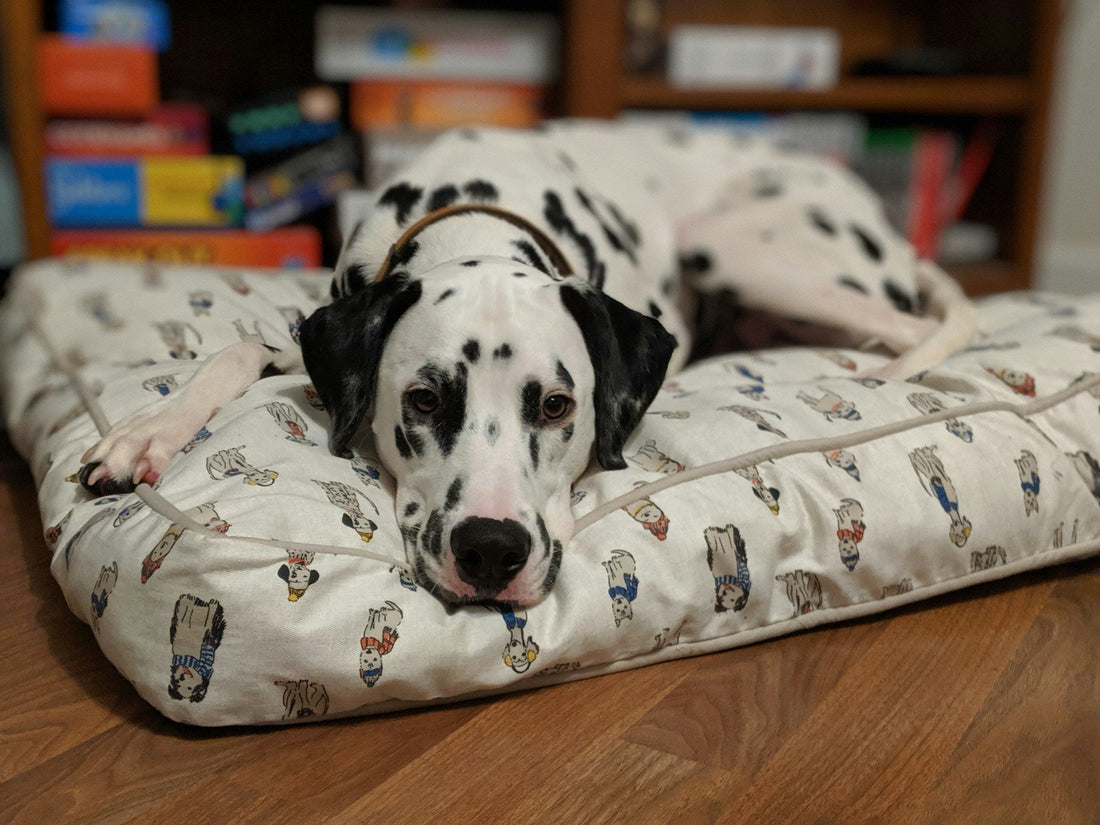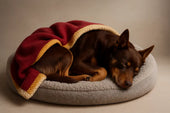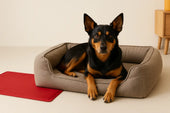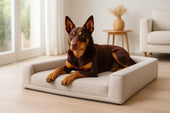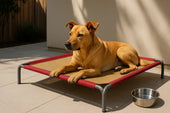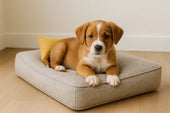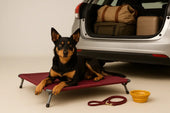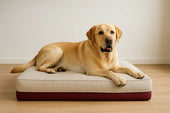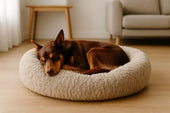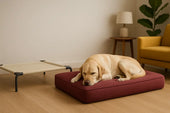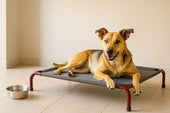Key Takeaways
- Learn to create a safe, comfortable, and personalised dog bed at home—no matter your experience level or budget.
- Save money, reduce waste, and make eco-friendly choices with upcycled and sustainable materials available in Australia.
- Understand the essential features of a great dog bed, from fabric types to support needs for various breeds, ages, and health conditions.
- Follow detailed, expert-approved, step-by-step instructions for both sewn and no-sew beds, with safety and hygiene top of mind.
- Discover practical design tips, cleaning strategies, and maintenance advice for long-lasting pet comfort.
- Find answers to common questions and expert recommendations specific to Australian pet owners and their climate needs.
Introduction
Australians are famous for their love of dogs. From loyal Kelpies on rural properties to pampered Cavoodles in city apartments, our canine companions deserve a safe, cosy place to rest. Yet, not every commercial dog bed meets the specific needs of your pet or your home environment—and quality dog beds can be surprisingly expensive, especially for larger breeds or pets with special requirements.
A homemade dog bed isn’t just a creative project; it’s a chance to customise comfort, reduce costs, and choose eco-friendly options that suit both your dog and your lifestyle. More Australian pet owners are opting for DIY solutions, using everyday materials to make beds that are easy to clean, durable, and perfectly sized.
Why make your own dog bed?
- Tailored comfort: You control the size, thickness, and materials, catering to your dog’s sleeping habits, age, and health needs.
- Cost savings: Repurpose old towels, doonas, or even furniture, keeping extra dollars in your pocket.
- Sustainability: Reduce landfill by upcycling items you already have—an approach supported by animal welfare groups like RSPCA Australia.
- Bonding: Involve your family in a fun, rewarding activity that benefits your furry friend.
“A clean, well-made bed gives your dog a sense of security and a dedicated space to unwind. Homemade beds can be even more comforting because they’re filled with familiar scents from your home.”
— Dr. Michael Hayward, Australian Small Animal Veterinarians
This guide will help you design and construct a dog bed that matches your dog’s personality, supports their health, and stands up to the Australian climate. Whether you’re a seasoned DIY-er or a first-time crafter, you’ll find solutions to fit any home, dog, or budget.
What to Consider Before Making a Dog Bed
Before you grab your scissors or hunt through your linen cupboard, take some time to think about the unique needs of your dog and your household. Designing a dog bed isn’t just about aesthetics—it’s about health, safety, and everyday practicality, especially in diverse Australian environments.
1. Size, Age, and Breed of Your Dog
- Measure your dog while they’re sleeping in their favourite position—sprawled, curled, or leaning against something. This ensures the bed is neither too cramped nor too large.
- Small breeds (e.g., Jack Russell Terrier, Toy Poodle): Need beds that provide a sense of enclosure and warmth.
- Medium breeds (e.g., Cocker Spaniel, Beagle): Prefer a balance of support and room to stretch.
- Large breeds (e.g., Labrador Retriever, German Shepherd): Require extra support for joints and a larger sleeping surface.
- Giant breeds (e.g., Great Dane): Often need custom, reinforced beds due to their weight.
- Puppies: Choose materials that are soft but sturdy, and avoid small parts that could be swallowed.
- Seniors or dogs with arthritis: Prioritise memory foam or orthopaedic padding and a low-entry design for easy access.
“Providing a supportive sleeping surface for older dogs or those with musculoskeletal issues is crucial. Orthopaedic beds can greatly improve quality of life.”
— Dr. Eloise Bright, Love That Pet Australia
2. Your Dog’s Sleeping Style
Observe where and how your dog sleeps:
- Curlers like beds with bolsters or sides for security.
- Sprawlers love flat, open mats.
- Leaning dogs prefer a pillow or raised side to rest their head.
- Burrowers (such as Dachshunds): Enjoy cave-style beds or blankets they can nest in.
3. Material Safety and Allergies
Australian dogs are frequently exposed to grass, pollen, and dust mites, making allergies a real concern. Choose materials that are:
- Hypoallergenic (e.g., tightly woven cotton, bamboo, or hemp).
- Non-toxic—avoid treated fabrics or foams with chemical odours.
- Easy to clean, as regular washing is essential in Australia’s warm, sometimes humid climate.
4. Durability and Washability
- Opt for machine-washable covers and tough fabrics (like denim, canvas, or outdoor fabric).
- Check that seams are double-stitched or reinforced for energetic dogs.
- If your dog spends time outdoors, choose UV-resistant and water-resistant materials.
5. Cost-Effectiveness and Sustainability
- Homemade beds can be as simple or as luxurious as you like—budget for essentials, but remember you can often reuse old doonas, pillows, or jumpers for stuffing or covers.
- Consider Australia’s push for sustainable pet ownership: upcycle where possible and avoid materials that contribute to landfill.
Quick Checklist
- Have you measured your dog in its sleeping position?
- Do you know your dog’s favourite sleeping style?
- Are the materials safe, hypoallergenic, and easy to wash?
- Will the bed withstand your dog’s habits (digging, chewing, drooling)?
- Can you wash or replace covers and stuffing as needed?
- Are your chosen materials suitable for the Australian climate (cool in summer, warm in winter)?
Materials and Tools You’ll Need
Choosing the right materials and tools is crucial for making a dog bed that is comfortable, safe, and long-lasting—especially in Australia, where climate and pet lifestyles vary. Below, you’ll find options for all budgets, including eco-friendly and upcycled choices, plus guidance on what to avoid.
Best Fabrics for Australian Dogs
- Cotton: Breathable and gentle on sensitive skin; perfect for most climates and for dogs with allergies. Look for 100% natural cotton if possible.
- Fleece: Soft and warm, ideal for cooler regions like Victoria or Tasmania, or for pets that feel the cold.
- Denim or Canvas: Extremely durable—great for chewers or active dogs, and suitable for both indoor and outdoor beds.
- Outdoor/Waterproof Fabrics: Use for verandas, decks, or travel beds. Available at major fabric stores in Australia (e.g., Spotlight).
- Sustainable Options: Hemp, bamboo, and organic cotton are increasingly available in Australia and recommended for environmentally conscious owners. For sustainable pet advice, visit RSPCA Australia’s resource page.
“Bamboo and hemp are fantastic for beds because they resist mould and dust mites—a real plus in humid or coastal Aussie homes.”
— Environmental pet care advice, RSPCA Australia
Safe and Non-Toxic Fillings
- Polyfill: Lightweight, inexpensive, and machine-washable. Suitable for most dogs.
- Memory Foam: Provides orthopaedic support for seniors or dogs with arthritis—easy to find as mattress toppers or cut to size.
- Old Pillows/Quilts: Reusing old bedding is cost-effective and adds comfort. Just check for lumps or wear.
- Recycled Clothes or Blankets: Adds familiar scents to help anxious pets settle.
- Wool: Natural and warm but can be irritating for some dogs—test first if you’re unsure.
Upcycled Household Items
- Old Jumpers and Sweaters: Perfect for no-sew beds or as soft covers.
- Foam Mattresses and Pillows: Cut to fit; ideal for larger or multiple-dog beds.
- Doona Covers and Towels: Excellent for easy-to-remove covers or extra cushioning.
- Wooden Crates or Drawers: Create a designer bed frame with a rustic or modern look.
Essential Tools
- Measuring Tape/Ruler: To ensure a perfect fit for your dog’s size and sleeping style.
- Scissors or Rotary Cutter: For clean, straight edges—sharp blades make the job much easier.
- Sewing Machine (recommended): For durable, professional seams, especially on thicker fabrics.
- Needle and Strong Thread: For hand-sewing small repairs or details.
- Pins or Safety Pins: For holding layers in place before sewing or tying.
- Fabric Marker or Chalk: To mark cutting lines without staining.
- Zippers, Velcro, or Buttons: For making removable, washable covers.
Tip: If you’re using recycled materials, wash everything before starting to remove dirt, odours, or pests.
What to Avoid
- Synthetic leathers and heavily dyed fabrics: These can contain chemicals that irritate sensitive skin.
- Beads, small buttons, or embellishments: Choking hazards, especially for puppies and chewers.
- Stuffing with foam offcuts or scraps not made for bedding: These may break down or release dust.
Step-by-Step Guide: Making a Simple Sewn Dog Bed
A sewn dog bed is sturdy, durable, and allows for plenty of customisation. Even if you’re not an experienced sewer, these instructions are easy to follow and adaptable for any dog size or style preference. Let’s walk through each step, with practical tips and insights relevant to Australian pet owners.
Step 1: Measuring Your Dog
- Have your dog lay down naturally in their favourite sleeping position—curled, stretched out, or sprawled.
- Measure from nose to base of tail and from the shoulder to the paw.
- Add 15–30 cm to both length and width measurements to ensure your dog has space to move and stretch.
“It’s better for a bed to be slightly too big than too small. Dogs like options—sometimes they want to curl up, sometimes they need to stretch out, especially in our warm summers.”
— Dr. Katrina Warren, Australian veterinarian and media personality (source)
Step 2: Cutting the Fabric
- Top and Bottom Panels: Cut two rectangles or ovals using your measurements, remembering a 2 cm seam allowance on all sides.
- Side Panel (optional for bolster-style beds): Cut a long strip as wide as you want the bed’s edge to be (usually 8–20 cm) and as long as the perimeter of your top/bottom panels.
- Mark all cuts using a fabric marker or chalk for precision.
Tip: For dogs who dig or nest, use a tough bottom fabric (like denim or canvas) and a soft, cosy top (fleece or cotton).
Step 3: Stitching the Bed Base
- Pin fabric pieces right sides together (the sides that will face out).
- Sew around three sides (or most of the way around for ovals), leaving one short side open for turning and stuffing.
- If adding a side panel:
- Sew the strip to the bottom panel first, then attach the top panel, again leaving a section open.
- Double-stitch seams for extra durability, especially if your dog is a chewer or heavy digger.
Step 4: Adding Filling and Closure
- Turn the bed right side out through the open section.
- Stuff with your chosen filling (polyfill, foam, old pillows, or recycled clothes). Distribute evenly for comfort.
- Don’t overfill; press down to check for softness and adjust as needed.
- Close the open seam with a hidden hand stitch or by sewing shut on your machine.
- Optional: Install a zipper or Velcro strip in the open section for easy removal and washing.
“A removable cover is a lifesaver in wet or muddy Aussie winters, especially if your dog loves the garden as much as the sofa!”
— Zoe, dog owner from Adelaide
Step 5: Optional – Removable and Washable Covers
- Cut a separate cover using the same pattern as your bed panels.
- Use durable, colourfast fabric for easy maintenance.
- Sew in a zipper, envelope fold, or Velcro along one side.
- Make a few spare covers to rotate while washing.
Step 6: Customising for Extra Comfort
- Bolsters: Roll up towels or stuff long fabric tubes to create sides for curlers or dogs who like a pillow.
- Memory Foam Inserts: For senior dogs or breeds prone to hip dysplasia.
- Cooling Pads: Insert a gel pad in the cover for summer.
- Personalisation: Add your dog’s name using iron-on letters or hand embroidery.
Example: Simple Rectangular Bed for a Medium Dog
Materials:
- 1 metre cotton for the top
- 1 metre canvas for the base
- 1–2 kg polyfill or an old pillow
- Zipper (optional)
Process:
- Measure and cut two 80x60 cm rectangles.
- Pin and sew three sides.
- Turn right side out, stuff evenly.
- Sew shut or attach zipper.
- Enjoy a custom, washable, and comfortable dog bed!
Visual tutorials can be found on Blue Cross UK’s No-Sew Dog Bed Video and Better Homes & Gardens Australia: Upcycled Pet Beds.
No-Sew Dog Bed: Quick and Easy Methods
Not everyone has a sewing machine or the time to stitch up a custom dog bed. Luckily, there are plenty of no-sew solutions that are budget-friendly, fast, and perfect for families—including kids who want to help. These methods are ideal for temporary beds, travel, or for owners who love to upcycle.
Using Old T-Shirts or Sweaters
Steps:
- Find a large, clean t-shirt or sweater—preferably one that holds your scent, which many dogs find comforting.
- Stuff the torso with old towels, jumpers, or even clean rags. Make sure the filling is distributed evenly and isn’t too lumpy.
- Tie off the sleeves and bottom with sturdy knots or secure with pet-safe rubber bands or string.
- Tuck in the neck hole or stitch it closed with a few quick hand stitches, or use safety pins if the bed is for gentle chewers only.
- Shape the stuffed shirt into a doughnut or rectangle, tucking the arms underneath for extra padding.
Benefits:
- Incredibly quick and uses items you already have.
- Your dog will love the familiar scent.
- Perfect for puppies or anxious rescue dogs needing comfort.
“Our rescue dog settled immediately on a bed made from my old hoodie. She’d spent weeks anxious on store-bought beds, but the familiar scent helped her relax instantly.”
— Tim, dog owner, Brisbane
The Knot-Tie Fleece Bed
This popular method is often called the “no-sew tie blanket” and works well for both dogs and cats.
Steps:
- Cut two large pieces of fleece or any soft, strong fabric to the desired bed size (add 10–15cm for the fringe).
- Stack the fabric squares, wrong sides together.
- Cut fringe around all edges—about 5–7cm deep and 2–3cm wide.
- Tie matching top and bottom fringe pieces together in tight knots. Leave a 20–30cm gap unknotted.
- Stuff the bed through the opening with polyfill, old towels, or pillows.
- Finish tying the last knots to seal the bed.
Tips:
- Fleece is ideal because it doesn’t fray, is inexpensive, and washes well.
- For dogs that chew, use shorter fringe and double knot.
See a video tutorial on Blue Cross UK’s website.
Repurposing Cushions and Pillows
- Pillowcase Bed: Place one or two old bed pillows inside a clean pillowcase or doona cover. Fold or tuck as needed to adjust the thickness. Replace stuffing as it flattens.
- Cushion Bed: Use outdoor seat cushions from patio furniture—these are often waterproof and durable. Cover with an old towel or fitted sheet for easy washing.
Filling and Shaping Without Stitching
- For a bolster-style bed, roll up towels and arrange in a circle or oval around a pillow core. Wrap tightly with a fitted cot sheet or large t-shirt to hold in place.
- Use a laundry basket or plastic tub lined with soft blankets for a raised, den-like effect.
Safety Considerations for No-Sew Designs
- Always secure loose fabric and filling—curious puppies can easily pull out stuffing.
- Avoid buttons, beads, or other small decorations.
- Check beds regularly for wear or torn spots, especially if your dog is a chewer.
“No-sew beds are great for travel or for dogs that go through beds quickly, but always supervise pets at first to make sure they aren’t tempted to tear out stuffing.”
— PetMD: DIY Dog Beds
Eco-Friendly and Upcycled Dog Bed Ideas
Sustainability is more than a trend—it's a responsibility, especially for Australian pet owners concerned about landfill, resource use, and the welfare of future generations. Making a dog bed at home is the perfect opportunity to reduce waste, save money, and craft something unique. Here’s how you can give new life to old items and help the planet at the same time.
Turning Old Furniture into Designer Beds
Wooden Drawers and Crates:
- Repurpose a sturdy old dresser drawer, wooden wine crate, or fruit box as the bed frame.
- Sand and paint the wood with non-toxic, pet-safe paint or sealant to avoid splinters.
- Add short furniture legs (or even rubber feet) for a raised effect, which helps keep the bed dry in damp climates.
- Line the inside with a custom cushion or pillow, covered with an easy-to-wash fabric.
Baskets and Suitcases:
- Large wicker baskets, storage tubs, or vintage suitcases also make great bed frames.
- Add a thick pillow or foam pad inside, and line with soft blankets.
See creative upcycled pet bed ideas at Better Homes & Gardens Australia.
Reusing Foam Mattresses and Pillows
- Cut foam mattress toppers or old mattresses to your dog’s size, then cover in a washable fabric.
- Stack layers for thicker, more supportive beds, especially for senior or arthritic dogs.
- Use foam from outdoor furniture cushions, which is designed to resist moisture and mildew—a huge plus for outdoor or veranda beds.
Sustainable Fabrics: Hemp, Organic Cotton, and Bamboo
- Hemp is naturally resistant to mould and dust mites, making it perfect for humid or coastal Australian homes.
- Organic cotton is soft and gentle, ideal for sensitive skin and puppies.
- Bamboo fabric is cool in summer, highly absorbent, and quick-drying—great for hot Aussie summers.
Many Australian online retailers now offer sustainable textiles and pet-friendly materials. Check Spotlight or local fabric stores for options.
“Sustainable pet ownership isn’t just about what you buy—it’s how you reuse and recycle at home.”
— RSPCA Australia
Minimising Waste: Tips for Environmentally Conscious Pet Owners
- Patch together fabric scraps from clothing, curtains, or other projects to create a vibrant, one-of-a-kind dog bed.
- Use old towels or flannel sheets as inner padding—just layer them for extra comfort.
- Repurpose old pet beds as outdoor or travel beds, or donate gently used bedding to animal shelters.
- Save fabric offcuts for repairs or future projects.
What to Avoid
- Avoid using heavily stained or synthetic fabrics that shed microplastics in the wash.
- Don’t use materials with strong chemical smells or that haven’t been washed, as they could irritate your dog’s skin.
Maintaining Your Homemade Dog Bed
A homemade dog bed is a wonderful investment in your pet’s comfort—but like any bedding, it requires regular cleaning and maintenance to stay hygienic, odour-free, and supportive. Australian households, with their love of the outdoors and frequent temperature swings, may need to wash dog beds more often than you’d expect. Here’s how to keep your creation fresh and long-lasting:
Cleaning and Washing Tips
- Wash covers weekly (or more often if your dog has allergies or sheds a lot). Machine-wash in cold or warm water with a mild, pet-safe detergent.
- Remove hair with a lint roller or vacuum before washing to prevent clogging your washing machine.
- Air-dry in direct sunlight when possible—sunlight naturally disinfects and helps kill dust mites.
- Wipe down waterproof liners with a vinegar-water solution or pet-safe cleaner.
- For memory foam inserts: Spot clean with a gentle soap and water solution, and air out thoroughly before reassembly.
“Regular washing isn’t just about odour control—clean bedding reduces your pet’s exposure to fleas, bacteria, and allergens, all of which are common in Australia’s varied climates.”
— Australian Veterinary Association
Keeping the Bed Hygienic and Odour-Free
- Sprinkle baking soda inside covers before washing to neutralise odours.
- Use removable covers wherever possible, as these are much easier to keep clean.
- Rotate between two or more covers so there’s always a fresh bed while one is in the wash.
- Dry completely after washing—damp beds can develop mould or mildew, particularly in humid regions like Queensland or coastal NSW.
Repairing Tears and Worn Areas
- Sew up small holes or tears immediately using a strong needle and thread. This prevents stuffing from escaping and deters dogs from pulling out filling.
- Reinforce weak seams with double stitching.
- Add patches from leftover fabric scraps for a colourful, practical fix.
When to Replace or Refurbish the Bed
- Flattened or misshapen beds may no longer provide adequate support—replace or add fresh stuffing when needed.
- If you notice persistent odours or stains that can’t be removed, consider making a new bed or replacing the affected materials.
- For puppies, incontinent dogs, or those with health issues, replace or wash beds even more frequently to prevent bacteria build-up.
Extra Tips for Australian Households
- During wet weather: Use a waterproof liner or move beds indoors to prevent dampness.
- For outdoor dogs: Check for ticks and insects hiding in bedding after time spent outside.
- Pet hair control: Brushing your dog regularly reduces the amount of fur embedded in the bed.
Safety Tips: Ensuring Your Dog’s Health and Comfort
Safety is at the heart of every successful homemade dog bed. Your pet’s bed should be more than comfortable—it should also be free from hazards and support your dog’s unique health needs. Here are the key safety factors to consider, with tips tailored to Australian conditions and expert advice.
Check for Choking Hazards
- Avoid small, loose items like buttons, beads, or decorative patches. These are tempting for puppies and chewers and can become dangerous if swallowed.
- Double-knot ties and secure seams to prevent your dog from pulling out stuffing.
- Use sturdy, pet-safe zippers or Velcro for removable covers—never pins or safety pins.
Choose Hypoallergenic and Non-Toxic Materials
- Stick with natural fabrics such as cotton, hemp, or bamboo, which are less likely to cause skin irritation.
- Avoid fabrics with strong chemical odours or those that haven’t been washed.
- Steer clear of fillings not designed for bedding (e.g., bean bag filler or foam scraps from unknown sources).
“Dogs with skin or respiratory sensitivities are better off with simple, natural bedding. Always check for reactions the first week and wash new materials before use.”
— Dr. Eloise Bright, Love That Pet Australia
Heat and Insulation for Australian Seasons
- In colder southern states, use fleece, wool, or thick cotton layers for warmth—especially for short-haired or elderly dogs.
- In tropical or summer conditions, opt for lightweight, breathable fabrics like bamboo or organic cotton.
- For outdoor beds, use waterproof, UV-resistant covers to protect against sun and rain.
Support for Senior and Arthritic Dogs
- Orthopaedic memory foam inserts provide crucial support for dogs with arthritis or hip dysplasia. Consider a low, flat entry for easy access.
- Use thicker padding and firmer beds for heavy breeds to prevent pressure sores.
“Older dogs often benefit from firmer, supportive beds that relieve pressure on joints. Customised foam or bolster beds are an excellent choice.”
— Dr. Katrina Warren, Australian veterinarian (Dr. Katrina’s Pet Advice)
Additional Safety Tips
- Wash and inspect beds regularly for broken seams or exposed stuffing.
- For chewers, use durable fabrics like canvas or denim and avoid loose parts.
- For puppies, ensure that everything is securely stitched and that the bed is easily washable.
Read more: Dog Bed Safety Guide – Vetstreet
Expert Insights and Real-Life Success Stories
Bringing in real-world perspectives and advice from professionals gives you both inspiration and reassurance. Many Australian pet owners have successfully made their own dog beds—and veterinarians frequently encourage custom bedding, especially when tailored to the animal’s specific needs.
What the Experts Say
“Providing a safe, clean, and comfortable bed is as important as food and exercise for your dog’s wellbeing. Dogs need a space where they feel secure and supported, especially as they age or if they suffer from anxiety or arthritis.”
— Dr. Michael Hayward, Australian Small Animal Veterinarians
“DIY dog beds allow owners to use materials familiar to their pet, reducing anxiety and promoting better sleep. For rescue dogs or pets prone to stress, homemade beds can make a real difference.”
— Dr. Eloise Bright, Love That Pet Australia
“Sustainable pet care isn’t about spending more, but about being smart with resources. Reusing, recycling, and upcycling for your dog’s bed is great for the planet and often preferred by pets.”
— RSPCA Australia
Real-Life Testimonials
-
“We have two Labradors who always destroyed store-bought beds. I made a bed from old canvas and an old mattress topper—three years later, it’s still their favourite, and it’s easy to throw the cover in the wash.”
— Zoe, Adelaide -
“Our anxious rescue Staffy would never settle until we used my husband’s old jumpers for a bed. She curls up in it every night now. It’s the only bed she hasn’t shredded!”
— Tim, Brisbane -
“We repurposed a big wooden wine crate and added a foam cushion. It’s easy to move outside in summer and back in during winter. The kids love that they helped paint it.”
— Emma, Sydney
Additional Resources and Inspiration
- PetMD: Customising Dog Beds for Health Needs
- Better Homes & Gardens Australia: Upcycled Furniture Pet Beds
These expert and owner stories show that homemade dog beds aren’t just about saving money—they’re about enhancing your dog’s comfort, health, and happiness in a way that fits your life.
Cost Comparison: Homemade vs. Store-Bought Dog Beds
One of the biggest motivators for making a dog bed at home is cost. But it’s not just about the money—you also gain flexibility, sustainability, and the joy of crafting something with your own hands. Let’s look at the real numbers and practical considerations for Australian pet owners.
Average Costs in Australia
| Factor | Homemade Dog Bed | Store-Bought Dog Bed |
|---|---|---|
| Initial Cost | $0–$60 (using upcycled or basic items) | $40–$300+ (depending on size, material, and brand) |
| Customisation | Full control over size, fill, cover | Limited to available options |
| Eco-Friendliness | Excellent with upcycling, minimal waste | Varies (many use synthetics or non-recyclable components) |
| Durability | High with quality fabrics, easily repaired | Variable—some beds last years, others degrade quickly |
| Maintenance | Covers are easy to remove, wash, or replace | Often not designed for easy cleaning or repairs |
| Support Options | Can include memory foam, bolsters, etc. | Orthopaedic beds often costly |
- DIY beds: Using items you already own (old doonas, pillows, jumpers, etc.) can bring the cost close to zero. Even if you buy new fabric or filling, most mid-sized homemade beds cost under $50.
- Store-bought beds: Prices for decent quality, medium-sized beds typically start around $70 and can easily exceed $200 for orthopaedic or designer options. Large, heavy-duty beds or those with premium features (memory foam, waterproofing) cost more.
“A homemade bed can save you hundreds, especially for large or multiple dogs. Plus, it’s easier to adjust or repair over time.”
— Choice Australia: Pet Bed Buying Guide
Pros and Cons of Each Approach
Homemade Dog Beds
Pros:
- Cost-effective
- Customisable for any dog, space, or style
- Sustainable, especially with upcycled materials
- Easy to repair, modify, or wash
- Personal—adds familiar scents, which many dogs love
Cons:
- Time investment required
- May not have the same polished look as designer brands
- Requires basic DIY or sewing skills
Store-Bought Dog Beds
Pros:
- Quick and easy solution
- Available in a range of colours, shapes, and sizes
- Many offer warranty or return policies
Cons:
- Can be expensive, especially for quality or orthopaedic options
- Limited ability to adjust size or support
- Cheaper beds may flatten quickly or fall apart
Making the Most of Your Budget
- Start with what you have at home—old bedding, jumpers, or towels are often enough.
- Consider investing in high-quality filling (like memory foam offcuts) if your dog has special needs—these can be found for much less than pre-made orthopaedic beds.
- For outdoor or travel beds, use lower-cost or recycled materials so you don’t mind if they get dirty or worn.
Remember: The best bed is one your dog loves and uses, not the one with the highest price tag.
Frequently Asked Questions
Australian pet owners often have practical, specific questions about homemade dog beds—especially if they’re new to DIY projects or have dogs with special requirements. Here are expert-backed answers to the most common queries:
How long does it take to make a dog bed at home?
- Simple no-sew beds: As little as 30 minutes, especially if you’re using pre-existing pillows, old jumpers, or a knot-tie fleece method.
- Sewn or custom beds: Plan for 1–2 hours, depending on size and complexity. If adding bolsters, removable covers, or personalised touches, allow extra time.
“With a plan and a few basic materials, most pet owners can make a bed in an afternoon.”
— Blue Cross UK: DIY No-Sew Dog Bed
Which materials are best for dogs with allergies?
- Natural fabrics like tightly woven cotton, hemp, or bamboo are ideal—these materials resist dust mites and are gentle on sensitive skin.
- Hypoallergenic filling: Use polyfill or memory foam (not wool or feathers, which can trigger reactions).
- Wash everything with a pet-safe, fragrance-free detergent before use.
Are homemade dog beds safe for puppies and chewers?
- Yes—if you take precautions. Avoid zippers, buttons, and any loose or small parts that could be chewed off and swallowed.
- For teething puppies or aggressive chewers, use strong fabrics like denim or canvas and double-stitch all seams.
- Supervise at first; some persistent chewers may still prefer a simple vet bedding or rubber mat.
How can I make a waterproof or outdoor-friendly bed?
- Use outdoor fabrics or waterproof mattress protectors as a liner under the cover.
- Repurpose materials designed for the elements, such as old outdoor cushions or tent fabric.
- Ensure the bed can be dried quickly, and wash often to avoid mildew or odours.
What is the best way to wash and dry a homemade bed?
- Removable covers: Wash in cold or warm water using a mild, pet-safe detergent. Line-dry in the sun for freshness and bacteria control.
- Foam inserts: Spot-clean as needed and allow to air dry thoroughly before replacing in the cover.
- For heavy shedders: Vacuum the bed and shake outside before washing to keep your machine clean.
How do I keep my dog from chewing their new bed?
- Provide ample chew toys and praise your dog for using them.
- Spray deterrents (pet-safe, available at vets and pet stores) can help break the habit.
- Choose durable, tightly woven fabrics and avoid loose parts or decorations.
- For some, start with a basic, inexpensive bed until the chewing phase passes.
Can I make a bed for my dog with joint issues?
- Absolutely. Use memory foam or orthopaedic inserts, ensuring the bed is thick and firm enough to support your dog’s weight.
- Keep the entry low and unobstructed so older dogs can climb on and off easily.
- If your dog’s needs change, it’s easy to adjust stuffing or covers with the homemade approach.
“Orthopaedic beds aren’t just for senior dogs. Any breed prone to hip or joint issues (such as Labradors or German Shepherds) will benefit from extra support.”
— Dr. Katrina Warren (Dr. Katrina’s Pet Advice)
Conclusion
Making a dog bed at home is more than just a money-saving project—it’s an opportunity to improve your pet’s comfort, reduce environmental impact, and personalise your dog’s space to perfectly fit their needs and your lifestyle. For Australian pet owners, homemade dog beds mean you can adapt to unique climate challenges, choose materials that match your values, and ensure hygiene and durability through regular maintenance.
Whether you choose a quick no-sew method with upcycled household items or invest time in a fully custom sewn bed with memory foam support, your dog benefits from a familiar, safe, and comfortable place to rest. Homemade beds can be changed as your dog grows, repaired if damaged, and styled to suit every corner of your home or yard.
Key points to remember:
- Tailor the bed to your dog’s breed, size, age, and preferred sleeping style.
- Use safe, hypoallergenic, and easy-to-clean materials—preferably those that are sustainable or upcycled.
- Prioritise durability and hygiene, especially in busy Australian households or outdoor settings.
- Seek expert advice when in doubt, and don’t hesitate to experiment—dogs are surprisingly adaptable and will appreciate your effort!
“A homemade dog bed reflects the care and attention you put into your pet’s daily life. When you see them sleeping soundly or relaxing in a bed you made, you’ll know it was worth every minute.”
— Dr. Michael Hayward, Australian Small Animal Veterinarians
Finally, remember to share your own creations and tips—Australian pet communities are full of resourceful, inventive owners, and your idea might inspire someone else. If you have leftover materials, consider donating them to local animal shelters or rescue groups.
Thank you for taking the time to craft a better life for your pet. If you have more questions or want to explore dog accessories, bedding, and health products, visit PetCareShed’s online shop for more inspiration and practical solutions tailored for Australian pets.

